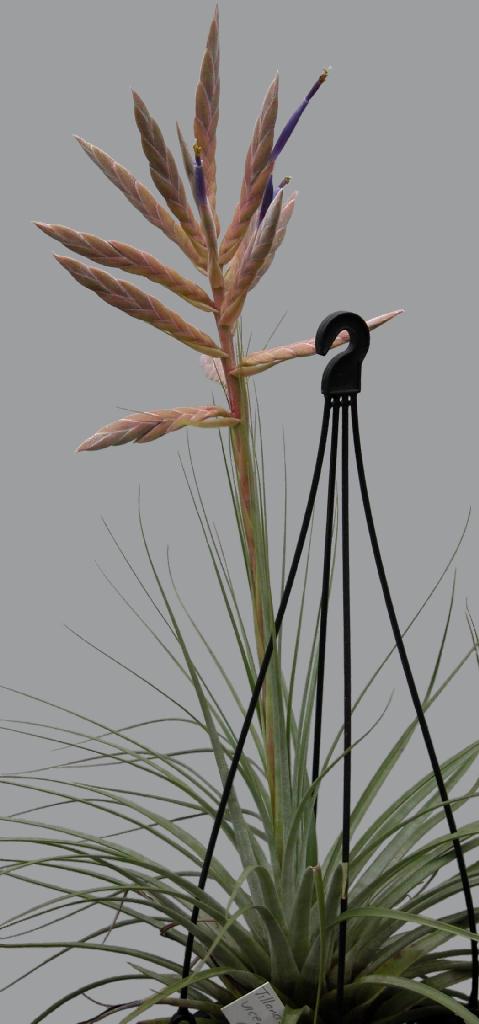

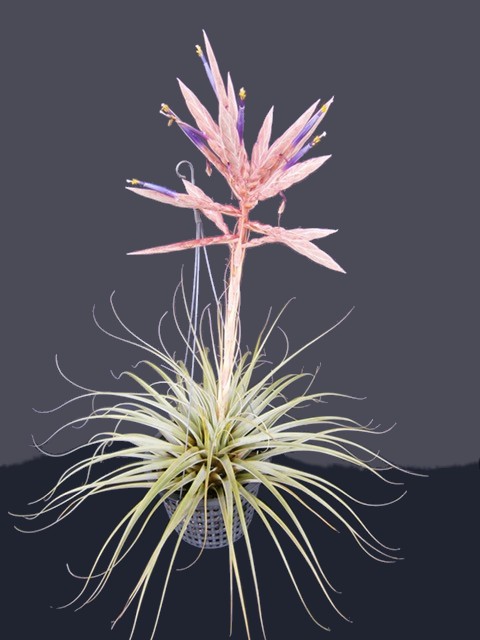

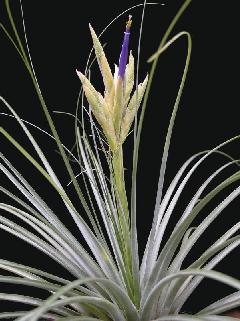
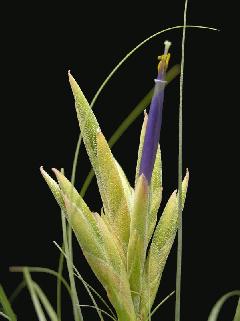
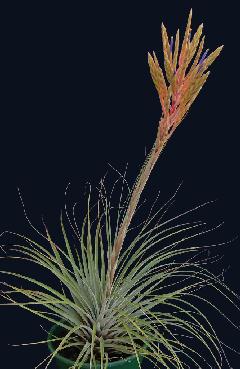
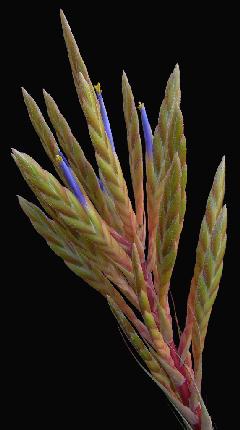
From Peter Tristram : "Similar to the ones I used to get and probably still have a couple, with the long scapes that sometimes decurve but basically all T. vicentina. I’ll look around tomorrow and see what’s in flower in that range to compare. Most are pink but I have one form that is quite orange – is this also?"
Greg Jones 05/19: "flowering for me at the moment is this very attractive Tillandsia from Chris many years ago as vicentina "question mark"."
Rob Bower "I bought what looks like the same plant as vicentina from Chris at the Feb Brom sale and its also almost ready to pop out a few flowers in a week or so – so I guess its vicentina."
Greg Jones "Thanks for the input Rob, I look forward to seeing your plant when you post photos. I have three clones, one from Peter with a much smaller flower spike which is a good match for vicentina, the one in the photo from Chris and another from Chris labeled large which is a similar size plant with much larger flower spike."
Chris Larson "In the dying stages of importing from Guatemala we received some very interesting plants – variations on the theme of vicentina and lampropoda - with various names. Different from what we had here before, but currently the closest sp is vicentina – I haven’t keyed each individual, but this is close enough to vicentina for me – but different to the older styles. I’m glad to see that they are thriving in the northern climate. I’m not sure we’ll see this type of stuff come in again."
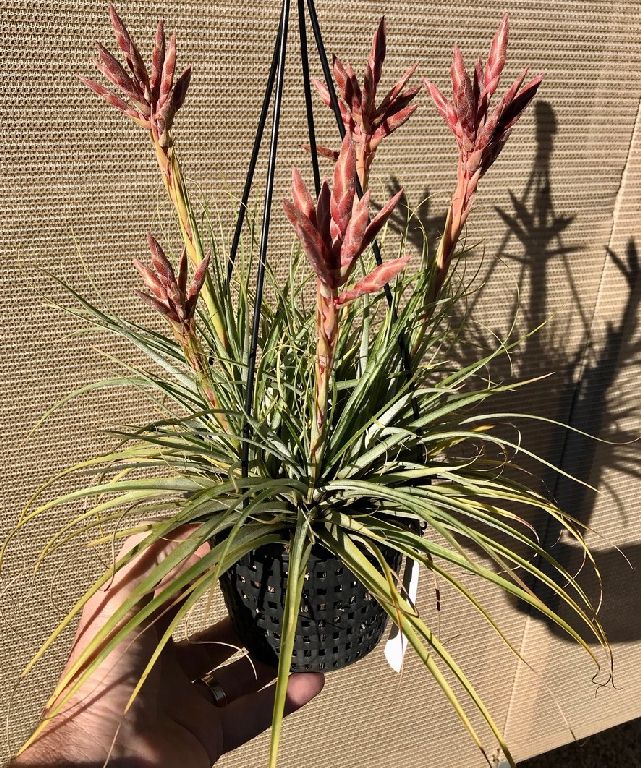
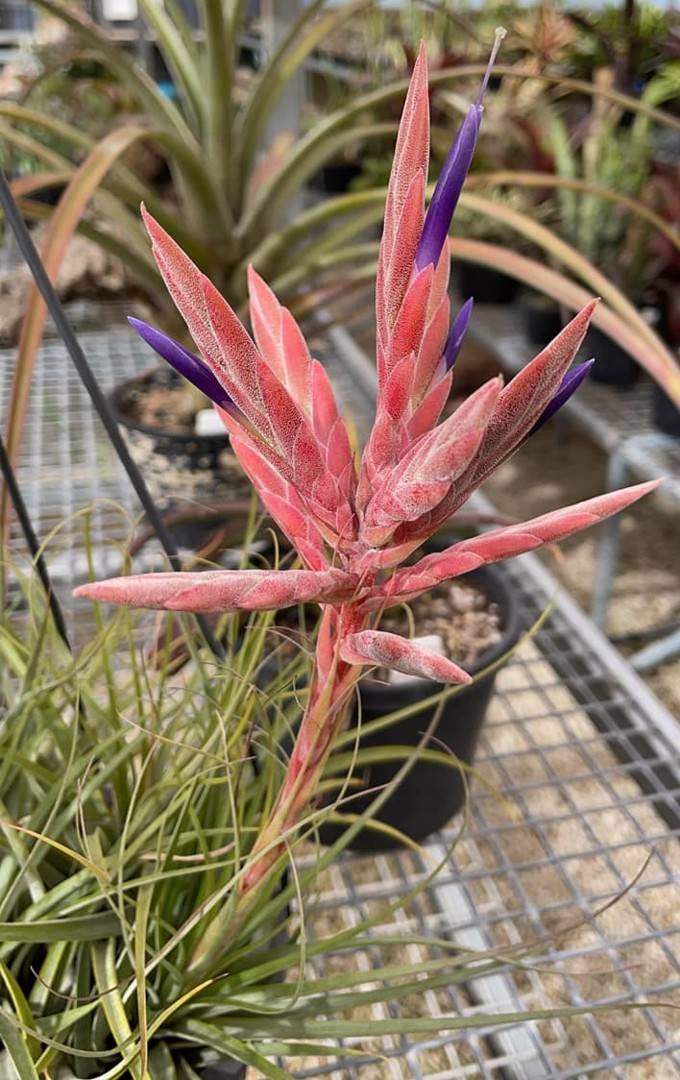
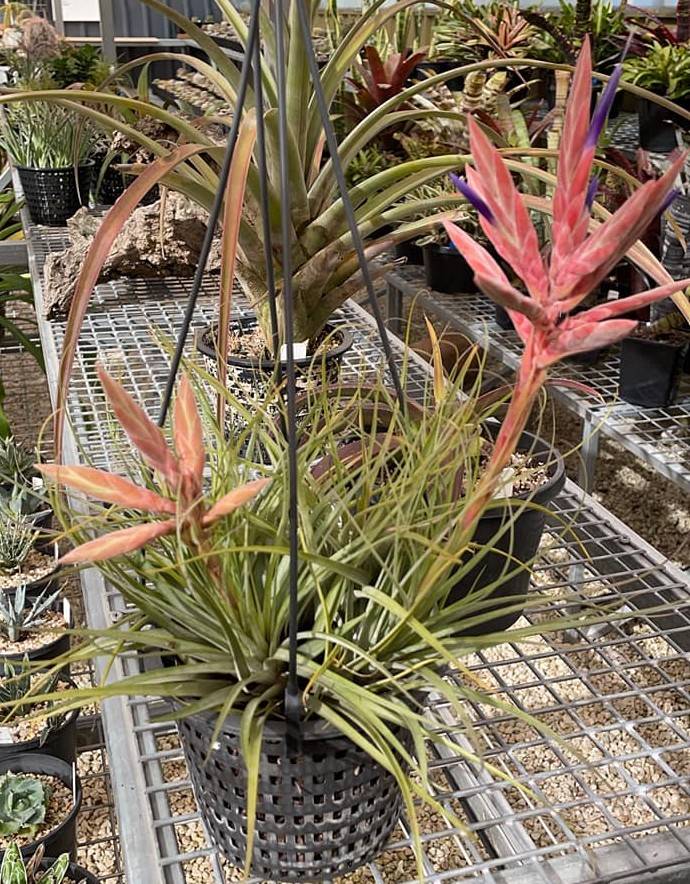
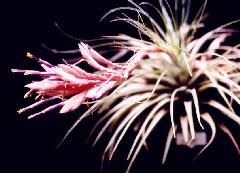
Tillandsia vicentina Standley, Jour. Wash. Acad. 13: 364. 1923.
Plants solitary, epiphytic; leaves numerous, about 25-30 cm. long, equalling the inflorescence, thin, 3-5 mm. wide at the middle, the bases l.5-2 cm. wide, brownish, the blades green on the upper surface and covered with closely appressed scales, beneath silvery, covered with coarse loose whitish-scales; scapes 15-25 cm. high, stout, covered with numerous overlapping bracts, these coarsely lepidote, their tips filiform-attenuate, their bases slightly inflated; spikes 5-11, simplc, digitate or shortly pinnate, sessile, 4-7 cm. long, their bracts compressed, 2-2.5 cm. long, pink, thin, loosely appressed and
overlapping for half their length, coarsely and loosely lepidote; sepals distinct, 2 cm. long, glabrous; corolla violet, exceeding the bracts 2-2.5 cm.; stamens conspicuously exceeding the corolla, the style long exserted.
Type in the U. S. National Herbarium, no. 1,137,360, collected on the Volcan de San Vicente, Salvador, altitude about 1500 meters, March 8 1922, by Paul C. Standley (no. 21588). Standley 21588 from the same locality represents the same species.
Related to T. digitata Mez and T. flabellata Baker, but readily distinguished by the coarse, loose pubescence of the leaves and bracts. The pubescence is similar to that of T. streptophylla Scheidw., but less coarse, and the leaves are not dilated at the base as in that species.
Tillandsia vicentina Standley var. glabra LB Smith Phytologia 20:567 1970 (omitted from S&D in error see below notes by Sue Gardner)
Tillandsia vicentina Standley var. wuelfinghoffii E Gross Bromelienstudien 19 1987 p82-85. Description from this shown below in brackets. See DeRebus I 1994 p38 where no reasons are given for deciding on this synonymy. Note that the only difference that Smith recorded was Floral bracts soon glabrous – not mentioned by E Gross!
Differs from Type in
(Leaf sheath 40mm wide not 15 – 20)
(Leaf blade next to sheath 15mm wide not 6 – 8, channelled not flat)
(Primary bract blade widely exceeds the spike not as long or longer)
(Inflorescence bipinnate not digitate)
(Spike 3cm long not 4 – 7, )
Floral bracts soon glabrous
(Petals 3cm long not 4cm)
Type locality Mexico, Chiapas, Venustiano Carranza, On Quercus, North side of Aguacatenango, near the lake, 1770m alt, 28/1/1965, Raven and Breedlove 20098 (US, type)
(Type locality on road from San Cristobal to Comitan (Chiapas), about 2000-2200m alt, Mexico. Holotype BGH68029 leg R Wuelfinghoff (HEID)
Tillandsia vicentina var. wuelfinghoffii E Gross, Trop. Subtrop. Pflanz. 60: 82-85. 1987
Differs from var. vicentina by the following
Sheath 4cm ( not 2cm) wide
Blade 15mm (not 6-8mm) wide
Blade of primary bract well exceeds the spike
Spike to 3cm long (not 4-7cm) not digitally arranged
Petals to 3cm (not 4cm) long
Holotype BGH. 68029, leg. R Wuelfinghoff. (HEID)
Habitat and range Road from San Cristobal near Comitan (State of Chiapas), 2000 – 2200 m, Mexico
Plant stemless, flowering to 30cm high, leaves forming a dense rosette ca as long as the inflorescence.
Leaf sheath distinct, long oval, 5cm long, 4cm wide, dark brown violet, white at the base, both sides dense appressed lepidote
Leaf blade narrow triangular acuminate, ca 20cm long, straight spreading outwards, next to sheath 1.5cm wide, weakly channelled, top side green, glabrous, underneath with dense silvery white scales.
Scape erect, round, 5mm thick, 15cm long, lepidote, covered densely by scape bracts.
Scape bracts almost leaflike, erect, with long filiform blades, lepidote, tip red.
Inflorescence short cylindric, 19cm long, 3cm wide, bipinnate, exceeding the leaves, ca 10 spikes.
Primary bracts longish oval, red, white lepidote, the bottom ones with filiform blades, the upper ones acuminate, the sheath of the lower bracts a little shorter than the spike, while the blade greatly exceeds
Spike subsessile to short stemmed, (4mm), ca 3cm long, 1.5cm wide, complanate, polystichous, 4 – 6 flowered, with 1 - 2 sterile floral bracts.
Rhachis thin, green, lepidote, visible at anthesis.
Flower erect, subsessile.
Floral bracts 20mm long, 10mm wide, erect, imbricate, exceeds the sepal, sharply carinate, red, at base green, densely white lepidote,
Sepal long lancelike, acuminate, 16mm long, thin, light green, glabrous, light red at tip, the posterior pair carinate, free.
Petal ligulate, erect, forming a tube, hardly spreading, 30mm long, violet, the base white.
Stamen and Style widely exceeding, Filaments white, Pollen yellow, style white with weak yellowish lobes, exceeds the stamens by 7mm.
var. vicentina
Leaf sheath 15-20mm wide, blade 6-8mm wide, flat, blade of primary bract as long or longer than the lower spikes, spikes 4-7cm long, arranged densely digitate or pinnate, petal 4cm long
var. wuelfinghoffii
Leaf sheath 40mm wide, blade next to sheath 15mm wide, channelled, blade of the primary bract widely exceeds the spike, spike 3cm long, not arranged digitately, petals 3cm long.
Notes from Sue Gardner's dissertation1982:
T. vicentina :
A second variety, inadvertently left out of the monograph (Smith & Downs, 1977: Smith, pers. comm 1980) differs by having glabrous floral bracts.( note – Smith said ‘soon glabrous’ suggesting that in life, trichomes were evident.)
I find a greater distinction between the varieties (see section on hybridisation). T. vicentina var. glabra L. B. Smith has longer internodes, and larger primary bracts that almost envelop the shorter branches. When investigated further, var. glabra may be elevated to species rank.
She examined the holotype: 1965 Raven & Breedlove 20098, Venustiano Carranza on Quercus, north side of Aguacatenango near lake 1770 m. And she examined var. glabra Chiapas: San Christobal de las Casas, 1949, Carlson 1598 (US), 1979, Gardner 1091 (US, SEL).
Preliminary notes by R Ehlers
Tillandsia vicentina var. wuelfinghoffii E. Gross
This new taxon was described in 1987 in the Bromelienstudien by Werner Rauh and Dr Elvira Gross. Although the plant is widely dispersed in Chiapas and in Guatemala, confusion still seems to prevail as to what this Tillandsia is.
Tillandsia vicentina Standley was described 1923. The holotype comes from El Salvador, Volcan de San Vicente. The plant has been found in Guatemala, Honduras and Nicaragua as well as El Salvador. Smith in his monograph shows this Tillandsia also for southern Mexico, which has certainly contributed to the problems.
Smith also refers to another hybrid T. vicentina x rodrigueziana? Rohweder from El Salvador. A second plant: Tillandsia vicentina var. glabra L. B. Smith was not accepted in Smith and Downs Monograph in 1977.
Sue Gardner writes however, in a personal note to L. B. Smith that this variety differs besides the glabrous flower bracts, to which the plant owes its name, by the longer internodes, and the longer primary bracts which almost enclose the lower spikes.
Unfortunately, I never became acquainted with such a plant.
Harry Luther in DeRebus 1 1994 p38 shows T. vicentina var. wuelfinghoffii as synonym of T. vicentina var. glabra L.B. Smith. On no account can I agree with this proposition. T. vicentina var. wuelfinghoffii has very densely scaled floral bracts and cannot be linked to var. glabra.
Adolfo Espejo-Serna et al. in the Mexican Bromeliad Checklist 2004 shows T. vicentina Standley and declares the States of Oaxaca and Chiapas as the range. Espejo also lists T. vicentina var. glabra and T. vicentina var. wuelfinghoffii as synonyms of T. vicentina.
On many trips through Chiapas, I could never find T. vicentina. There is only the Tillandsia vicentina var wuelfinghoffii as described by Elvira Gross. It is very wide-spread. In Guatemala however, as well as T. vicentina, you also find plants like T. vicentina var. wuelfinghoffii, but not in the same areas.
I now show the two plants under discussion, where it is very easily obvious that we are talking about two completely different plants. In my opinion, it is absolutely justifiable that var. wuelfinghoffii should remain. The plant with its much wider, dark green, thin, somewhat shiny leaves with the almost black sheaths, differs very clearly. The inflorescence is not densely digitate rather more long cylindric, composed of much shorter and wider spikes, the sheaths of the primary bracts well exceed the spikes, the floral bracts are crimson not pink, and the petals are smaller.
The plant grows well and is in many plant collections. They easily offset after flowering and after a few years are flowering once again.
The original description of T. vicentina var. wuelfinghoffii follows: